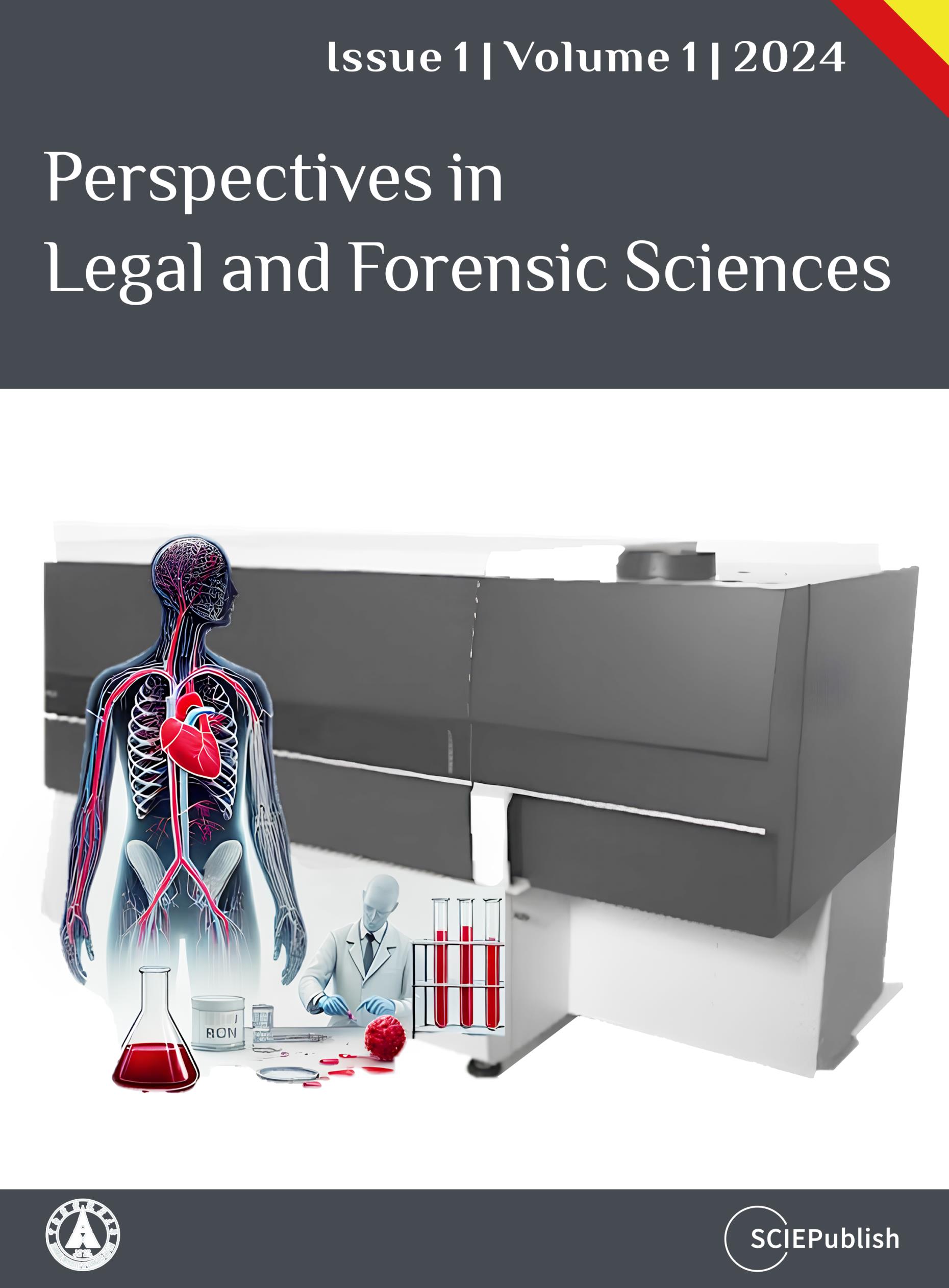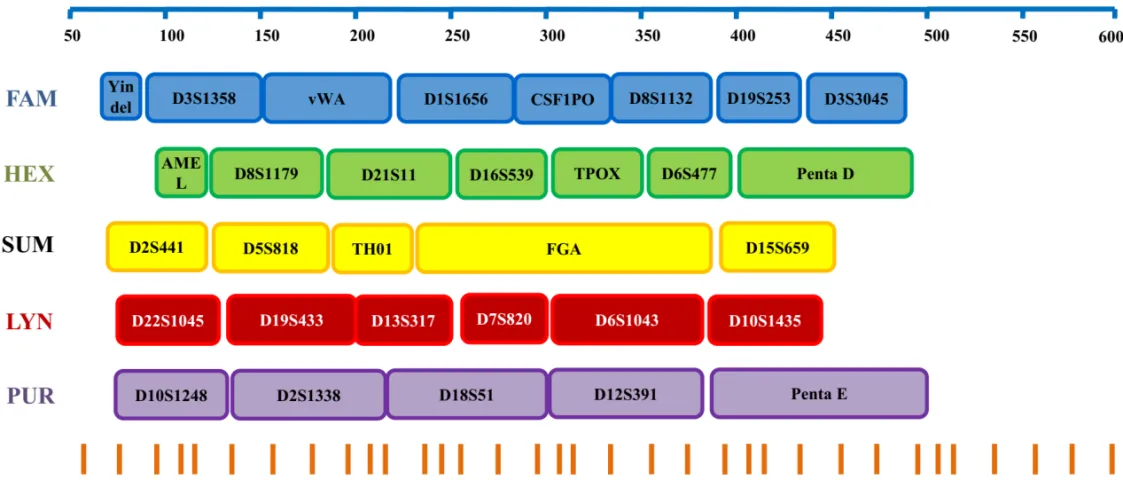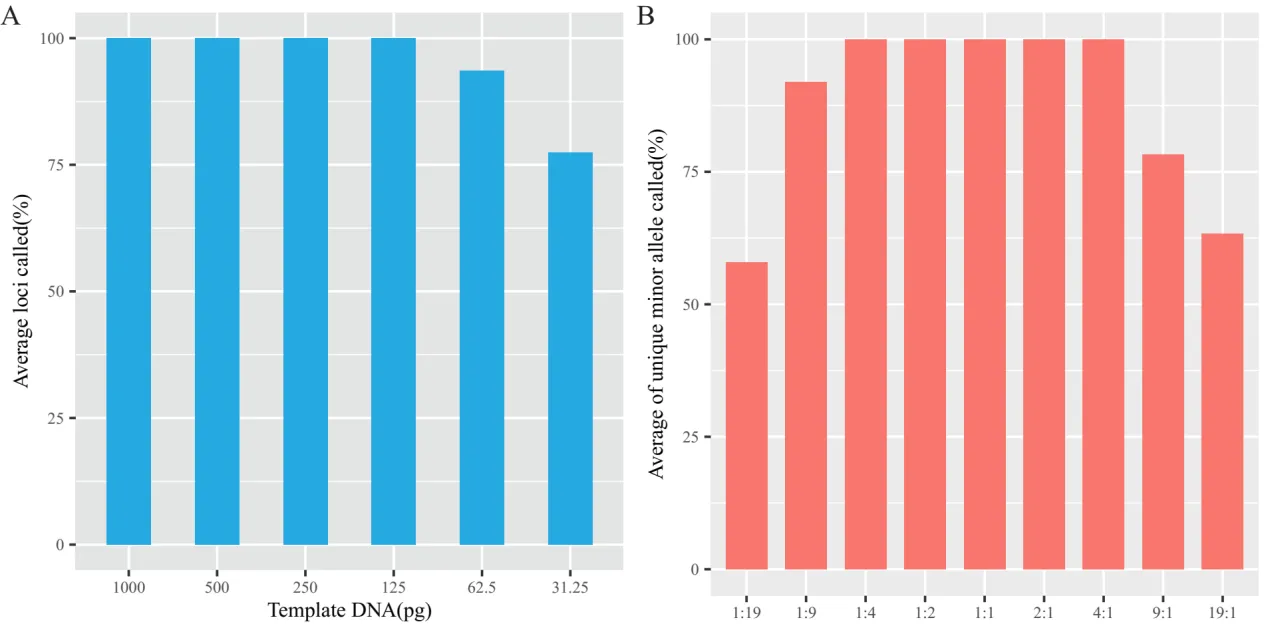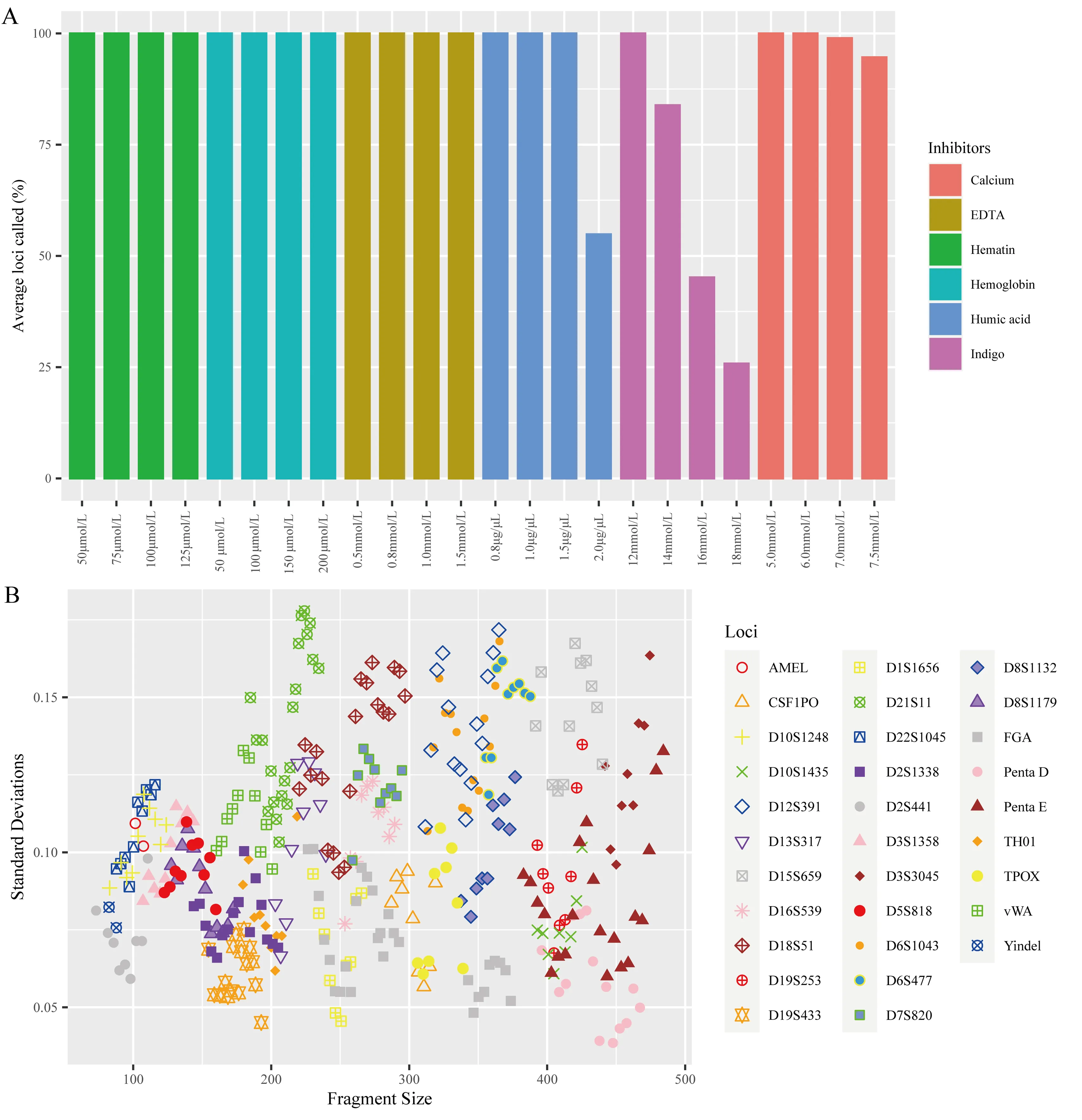1. Introduction
Short tandem repeats (STRs), in which the core motif consists of 2 to 7 nucleotides, have been widely used in paternity tests and individual identification because of their highly polymorphic characteristics and stable inheritance in the human genome [
1,
2,
3]. Until now, STR genotyping based on polymerase chain reaction (PCR) and capillary electrophoresis (CE) has been a gold standard in the field of forensics since it was first applied in 1991 [
4,
5]. At present, numerous commercial STR kits have been developed for the construction of forensic DNA databases over the last two decades since the generalization of the Combined DNA Index System (CODIS) [
6] and the expanded CODIS [
7], such as PowerPlex 21 [
8], PowerPlex Fusion System [
9], and Microreader 20A ID system[
10]. Additionally, to meet all the requirements of the expanded CODIS and the Chinese National Database (CND) [
11,
12], several commercial kits with high discrimination and high sensitivity have been developed, such as Huaxia Platinum System [
13] and VeriFiler Plus System [
14]. However, with the rapid growth of STR genotypes assembled from the expanded CODIS loci in the databases, there is a potential for increased adventitious matches [
12]. To increase the discrimination power and minimize adventitious hits in forensic STR testing, we should add additional non-CODIS loci to the newly designed panels to provide more practical information for personal identification and paternity testing [
15] and meet the needs of current database construction.
In this study, a novel 31-locus and 6-dye multiplex system has been developed. This system contains all 23 recommended non-overlapping core loci in the expanded CODIS and the CND (D1S1656, D2S441, D2S1338, D3S1358, D5S818, D6S1043, D7S820, D8S1179, D10S1248, D12S391, D13S317, D16S539, D18S51, D19S433, D21S11, D22S1045, CSF1PO, FGA, TH01, TPOX, Penta D, Penta E, and vWA), six non-CODIS loci (D3S3045, D6S477, D8S1132, D10S1435, D15S659, and D19S253) that were highly polymorphic in Chinese populations, and two sex-determining loci (Y-indel and Amelogenin). The Y-indel can be used to verify the result of the Amelogenin locus and prevent erroneous sex determination for mutations in the Amelogenin fragment [
16,
17]. The 29-plex STR multiplex system possesses high compatibility with various commercial STR kits, such as PowerPlex 21, PowerPlex Fusion System, Microreader 20A ID system, Huaxia Platinum System, and VeriFiler Plus System. It not only contains 20 CODIS loci but also includes 9 non-CODIS loci, which will greatly improve the ability of individual identification and is also suitable for database construction. This study aimed to verify the efficiency and accuracy of the 29-plex STR multiplex system. Hence, sensitivity, mixture, inhibitor, reproducibility, concordance, PCR condition, species specificity, sizing precision, and stutter calculation were studied. The 29-plex STR multiplex system was validated following the recommendations of the Scientific Working Group on DNA Analysis Methods (SWGDAM).
2. Materials and Methods
2.1. Sample Collection
This study was approved by the Ethics Committee of Southern Medical University (2020-001). Blood card samples from 211 unrelated Guangdong Han individuals (111 males and 100 females) were obtained with informed consent. The individuals who participated in this study were randomly selected, and they were descendants of non-consanguineous marriages of indigenous Han Chinese for more than three generations. Control DNA 9948 and control DNA 9947A were provided by AGCU ScienTech Incorporation (Wuxi, China). Nine non-human samples from
E. coli, dog, chicken, cat, rat, rabbit, sheep, macaque, and cow were obtained for the species specificity study. In addition, 18 casework samples were selected from the Guangzhou Forensic Science Institute.
2.2. PCR Amplification
Six-dye fluorescent chemistry was used, and a schematic diagram of the fluorescence detection method is shown in . Primer sequences for all loci are provided in Table S1. The DNA was quantified using the Quantifiler Trio DNA Quantification Kit (Thermo Fisher Scientific, Waltham, MA, USA) on the QuantStudio™ 7 Flex Real-Time PCR System (Thermo Fisher Scientific, Waltham, MA, USA). DNA samples were amplified on a GeneAmp® PCR System 9700 thermal cycler (Thermo Fisher Scientific, Waltham, MA, USA). The PCR reaction system consisted of 4.0 μL SUPER MIX, 2.0 μL primers, 0.1–2.0 ng extracted DNA samples, or 1.2 mm punch of the FTA card, and ddH2O was added to obtain a final reaction volume of 10 μL. PCR cycling was carried out as follows: initial denaturation at 95 °C for 5 min; 28 cycles of 94 °C for 15 s, 61 °C for 40 s, and 63 °C for 70 s; followed by a final extension at 60 °C for 5 min for direct amplification or 60 ℃ for 0 min for extracted DNA samples, and then holding at 4 °C. Control DNA 9948 and deionized water were amplified simultaneously for the control in each PCR reaction.
. The fragment positions of all loci included in the 29-plex STR multiplex system.
Electrophoresis was performed on an Applied Biosystems 3500XL Genetic Analyzer using 36-cm capillary arrays with POP-4 Polymer (Life Technologies, Foster, CA, USA). A total of 1.0 μL of amplified product or 1.0 μL of the allelic ladder was added to a mixture of 10 μL of deionized formamide (Hi-Di, Applied Biosystems) and 0.3 μL of Marker SIZ-600 (AGCU ScienTech, Wuxi, China). The samples were denatured for 3 min at 95 °C and then chilled on ice before electrophoresis. The electrophoretic separations were performed on an Applied Biosystems 3500XL and 3130XL Genetic Analyzer by injection for 6 s at 1.2 kV, with the spectral calibration file established using the 6 Dye Matrix Standards. GeneMapper ID-X software v1.6 analyzed fragment sizes and genotyping data with the analysis threshold of 50 RFU.
2.4. Sensitivity and Mixture Study
To verify the sensitivity of the 29-plex STR multiplex system, serial dilutions of control DNA 9948 (1, 0.5, 0.25, 0.125, 0.0625, and 0.03125 ng in 10 μL of PCR reaction volume) were prepared and amplified. Subsequently, the call rate (the number of observed loci divided by 31 (male sample) or 30 (female sample)) was determined for each dilution.
To estimate the ability of the 29-plex STR multiplex system for detecting mixtures, various mixture samples of control DNA 9948 and control DNA 9947A (1:1, 1:2, 1:4, 1:9, 1:19, 19:1, 9:1, 4:1, 2:1, and 1:1) were amplified. The call rate was determined for each mixture.
2.5. Inhibitor Study
In the inhibitor study, 1 ng of control DNA 9948 was respectively mixed with six common inhibitors at the following concentrations: 50, 75, 100, and 125 μmol/L hematin; 50, 100, 150 and 200 μmol/L hemoglobin; 0.5, 0.8, 1.0 and 1.5 mmol/L EDTA; 0.8, 1.0, 1.5 and 2.0 μg/μL humic acid; 12, 14, 16 and 18 mmol/L indigo, and 5.0, 6.0, 7.0, and 7.5 mmol/L calcium.
2.6. Species Specificity
Nine common types of non-human samples (E. coli, dog, chicken, cat, rat, rabbit, sheep, macaque, and cow) at 5 ng input amount were amplified to assess the species specificity of the 29-plex STR multiplex system.
2.7. Casework Samples and Reproducibility
Casework samples were provided by Guangzhou Forensic Science Institute (Guangzhou, China), which included hair (three), nails (one), blood (five), sperm (two), and cigarette butts (seven). All casework samples were amplified using a GeneAmp® PCR System 9700 thermal cycler and subsequently electrophoresed twice by the same operator using two different instruments (3500XL and 3130XL) to evaluate the reproducibility of the 29-plex STR multiplex system.
2.8. Sizing Precision and Stutter Calculation
To evaluate size precision, 24 allelic ladder samples were tested on a 3500XL Genetic Analyzer, and the average size and standard deviation were computed. Furthermore, the stutter value was calculated by dividing the stutter peak height by the true allele peak height.
2.9. Population and Concordance Study
A total of 211 unrelated Guangdong Han samples (111 males and 100 females) were tested. Arlequin v.3.5 was used to estimate the linkage equilibrium (LE) and Hardy-Weinberg equilibrium (HWE) [
18]. Relevant forensic parameters based on 29 autosomal STRs were calculated using the STRAF (STR Analysis for Forensics) online tool [
19], such as gene diversity (GD), polymorphism information content (PIC), probability of match (PM), power of discrimination (PD), observed heterozygosity (Ho), power of exclusion (PE), typical paternity index (TPI), the combined power of discrimination (CPD), and the combined power of exclusion (CPE). For the concordance study, fifty samples were also amplified using the PowerPlex 21, and the corresponding genotypes were compared with those generated by the newly developed 29-plex STR multiplex system.
3. Results and Discussion
3.1. PCR Condition Study
3.1.1. Cycle Number
To choose the best cycling number of the 29-plex STR multiplex system, 1 ng of control DNA 9948 was amplified at 26, 27, 28, 29, 30, 31, and 32 cycles. The results showed that all loci were observed at 26–32 cycles. As shown in Figure S1, the corresponding peak height increased gradually as the number of cycles increased. When the number of cycles was 28–30, the peak of each locus was complete, and the peak height was balanced. Therefore, the most appropriate number of cycles is 28–30.
3.1.2. Annealing Temperature
For the annealing temperature test, temperatures of 57, 58, 59, 60, 61, 62, 63, and 64 °C were tested using 1 ng of control DNA 9948. The results showed that no allele drop-out or artifact peaks were observed at annealing temperatures between 57 and 64 °C (Figure S1). The peak height was more balanced when the annealing temperature was 57–61 °C. However, the peak height of D10S1248 was relatively low at annealing temperatures of 62–64 °C. Therefore, the optimal annealing temperature was set to 57–61 °C.
3.1.3. Concentration of PCR Components
The reaction components of the 29-plex STR multiplex system involve the SUPER MIX and primers. The concentration of these components is closely correlated with the quality and accuracy of the genotyping results. 1 ng of control DNA 9948 was amplified using different volumes of SUPER MIX: 2.5 μL (0.25×), 5 μL (0.5×), 7.5 μL (0.75×), 10 μL (1.0×), 12.5 μL (1.25×), 15 μL (1.5×), and 17.5 μL (1.75×). In addition, 5.0 μL of primer and the necessary amount of ddH2O were added to achieve a final reaction volume of 25 μL. All loci were observed at SUPER MIX concentrations of 0.75× to 1.25× (Figure S2). However, less than 20% of loci were obtained at SUPER MIX concentrations of 0.25× and 1.75×. More than 90% were detected at a concentration of 0.5×, and more than 60% were detected at a concentration of 1.5× with the most fragment dropout. For the primer study, the primer was added at the following volumes: 1.25 μL (0.25×), 2.5 μL (0.5×), 3.75 μL (0.75×), and 5.0 μL (1.0×). Additionally, 10.0 μL of SUPER MIX, 1 ng of extracted DNA samples, and ddH2O were added to achieve a final reaction volume of 25 μL. As shown in Figure S3, when the primer concentrations were 0.25×, 0.5×, 0.75×, and 1.0×, full STR profiles were generated, and no allele drop-out or allele drop-in was observed. Therefore, the key components within a certain range of fluctuations are not affected.
3.2. Sensitivity and Mixture Study
Trace DNA may be present at a crime scene, so assessing the sensitivity of the 29-plex STR multiplex system is necessary. A serial dilution test of control DNA 9948 from 1 to 0.03125 ng was conducted in triplicate. Full profiles were obtained with DNA input above 125 pg using a 50 RFU threshold. However, when the total input DNA was 62.5 pg, the call rate reached 93.6%. At 31.25 pg of DNA input, 77.4% of the loci were detected (A).
DNA mixtures are common in casework, so we conducted a mixture study to evaluate imbalanced mixed samples. Artificial mixtures were made using control DNA 9948 and control DNA 9947A. The total input of DNA was 1 ng. The results showed that all loci were observed for ratios of 1:1, 1:2, 1:4, 4:1, and 2:1. At 1:9, 1:19, 9:1, and 19:1, some allelic drop-out for the minor contributor was observed (B). When the mixture ratios were 1:9 and 9:1, the call rates were 91.9% and 78.3%, respectively. In addition, the call rates were 58.0% and 63.3% for 1:19 and 19:1, respectively. Thus, the lower limit ratio of mixture detection was 1:4.
3.3. Inhibitor Study
Samples obtained from forensic cases often contain various PCR inhibitors, which may affect the genotyping profiles. Therefore, it is necessary to assess the stability of the 29-plex STR multiplex system. Six types of common inhibitors were tested in the inhibitor study. The inhibitory results are shown in A. The full profile was observed with hematin concentration up to 125 μmol/L, hemoglobin up to 200 μmol/L, EDTA up to 1.5 mmol/L, humic acid up to 1.5 μg/μL, indigo up to 12 mmol/L, and calcium up to 6.0 mmol/L. However, when the concentration of humic acid was 2.0 μg/μL, only 54.8% of loci were detected. A total of 83.9%, 45.2%, and 25.8% of loci were detected at indigo concentrations of 14 mmol/L, 16 mmol/L, and 18 mmol/L, respectively. In addition, calcium concentrations at 7.0 mmol/L and 7.5 mmol/L displayed loci detection rates of 98.9% and 94.6%, respectively. Therefore, the 29-plex STR multiplex system is relatively stable.
. (A) The results of the sensitivity study based on the call rate of control DNA 9948. (B) The average call rate for different male/female mixtures.
. (A) The average call rate for six common inhibitors of hematin, hemoglobin, EDTA, humic acid, indigo, and calcium with different concentrations mixed in control DNA 9948. (B) The precision of the 29-plex STR multiplex system across 24 injections on a 3500XL Genetic Analyzer.
DNA from common non-human samples (
E. coli, dog, chicken, cat, rat, rabbit, sheep, macaque, and cow) was used to test the species specificity of the 29-plex STR multiplex system. The results indicated that, except for macaque, no corresponding peak above 50 RFU was observed in the other animal samples (Figure S4). Notably, FGA, D13S317, D6S1043, D2S1338, D8S1132, D8S1179, and Amelogenin loci were identified in the macaque. This finding indicates the genetic similarities between humans and macaques in the non-coding DNA range [
20].
3.5. Case Samples
Eighteen forensic casework samples were amplified using the 29-plex STR multiplex system. The results showed that all alleles were obtained, indicating that this system can detect case samples.
3.6. Reproducibility
Eighteen samples were tested twice on two different instruments (3500XL and 3130XL) using the 29-plex STR multiplex system. The results showed that the genotypes of all samples were consistent.
3.7. Sizing Precision and Stutter Calculation
The allele-sizing precision was calculated from 24 analyzed allelic ladders (B). The standard deviation ranged from 0.039 bp (Penta D) to 0.178 bp (D21S11), indicating that the detection system had good performance precision. Stutter peaks are a result of strand slippage during PCR amplification. The most common stutter is one unit in length smaller than the true allele [
21]. As shown in Table S2, the mean stutter percentage value ranged from 0.49% (Y-indel) to 11.71% (D12S391). The average stutter plus three standard deviations were used to set the stutter filter threshold in the 29-plex STR multiplex system for GeneMapper® ID-X Software v1.6.
3.8. Population and Concordance Study
A population study was carried out using 211 unrelated Guangdong Han individuals (111 males and 100 females) from China. No deviations from LD (
p < 0.00006158) and HWE (Table S3,
p < 0.001724) of 29 autosomal STRs were detected in Guangdong Han after applying Bonferroni corrections. The allelic frequencies and relevant forensic parameters of the 29 STR loci are shown in Table S3. The results showed that the GD values of 29 STR loci ranged from 0.5971 (TPOX) to 0.9145 (Penta E). Additionally, PIC ranged from 0.5375 (TPOX) to 0.9061 (Penta E), while Ho varied between 0.5924 (TPOX) and 0.9289 (Penta E). TPI had a minimum value of 1.2267 (TPOX) and a maximum value of 7.0333 (Penta E). In addition, the CPD and CPE of the 29 STRs also reached 1–7.16 × 10
−35 and 1–1.98 × 10
−12, respectively, which were higher than frequently used commercial kits (Table S4).
Fifty samples were also amplified using the PowerPlex 21 for concordance study. The genotypes of 21 loci (D1S1656, D2S1338, D3S1358, D5S818, D6S1043, D7S820, D8S1179, D12S391, D13S317, D16S539, D18S51, D19S433, D21S11, CSF1PO, FGA, TH01, TPOX, vWA, Penta D, Penta E, and Amelogenin) obtained from both kits were identical.
4. Conclusions
The 29-plex STR multiplex system can simultaneously amplify 29 autosomal STR loci, Y-indel, and Amelogenin with six-dye fluorescent chemistry. We conducted a series of experiments to verify the performance of the 29-plex STR multiplex system. The results showed that the 29-plex STR multiplex system exhibited good sensitivity, mixture samples, and inhibitor tolerance performance. This 29-plex STR multiplex system contains all the loci included in the PowerPlex 21 commonly used in forensic testing at present, where the CPD and CPE reached 1–7.16 × 10−35 and 1–1.98 × 10−12, respectively. This system adds more loci conducive to forensic cases, improving the power of personal identification and paternity testing and meeting the needs of current database construction.
Supplementary Materials
The following supporting information can be found at: https://www.sciepublish.com/article/pii/149, Figure S1: The heat map of the average peak height about different cycle numbers and annealing temperatures; Figure S2: The electrophoresis results of amplification specificity under different SUPER MIX concentrations; Figure S3: The electrophoresis results of amplification specificity under different primer concentrations; Figure S4: The electrophoresis results of non-human DNA samples; Table S1: Primer details of for 31 loci; Table S2: Values of stutter ratio and recommended filter for 31 loci; Table S3: Allelic frequencies and relevant forensic parameters for 29 autosomal loci; Table S4: CPD and CPE of the 29-plex STR multiplex system for 211 Guangdong Han individuals in different commercial kits.
Acknowledgments
We thank all reviewers for their constructive comments.
Author Contributions
C.L. and M.W. designed this study. C.Y. and M.W. wrote the manuscript. C.Y., H.L., X.L., Z.Y., C.L., and L.C. conducted the experiments. G.H., Q.X. and W.D. analyzed the results. C.L. and M.W. revised the manuscript. All the authors reviewed the manuscript.
Ethics Statement
This study was approved by the Ethics Committee of Southern Medical University (Approval Number: 2020-01) and was conducted in accordance with the standards of the Declaration of Helsinki.
Informed Consent Statement
Informed consent was obtained from all subjects involved in the study.
Funding
This study was supported by the Science and Technology Program of Guangzhou, China (grant numbers: 2019030014 and 2019030016).
Declaration of Competing Interest
The author declares no conflict of interest.
Data Availability Statement
The data that support the findings of this study are available on request from the corresponding author.
References
1.
Ensenberger MG, Lenz KA, Matthies LK, Hadinoto GM, Schienman JE, Przech AJ, et al. Developmental validation of the PowerPlex
® Fusion 6C System.
Forensic Sci. Int. Genet. 2016,
21, 134–144.
[Google Scholar]
2.
Li S, Chen L, Wang Y, Xu Q, Liu H, Li Y, et al. Developmental validation of a 6-dye STR kit with 27 loci.
Int. J. Legal. Med. 2018,
132, 335−342.
[Google Scholar]
3.
Schmitt C, Benecke M. Five cases of forensic short tandem repeat DNA typing.
Electrophoresis 1997,
18, 690–694.
[Google Scholar]
4.
Edwards A, Civitello A, Hammond HA, Caskey CT. DNA typing and genetic mapping with trimeric and tetrameric tandem repeats.
Am. J. Hum. Genet. 1991,
49, 746.
[Google Scholar]
5.
Hagelberg E, Gray IC, Jeffreys AJ. Identification of the skeletal remains of a murder victim by DNA analysis.
Nature 1991,
352, 427−429.
[Google Scholar]
6.
Hares DR. Expanding the CODIS core loci in the United States.
Forensic Sci. Int. Genet. 2012,
6, e52-4.
[Google Scholar]
7.
Hares DR. Selection and implementation of expanded CODIS core loci in the United States.
Forensic Sci. Int. Genet. 2015,
17, 33−34.
[Google Scholar]
8.
Ensenberger MG, Hill CR, McLaren RS, Sprecher CJ, Storts DR. Developmental validation of the PowerPlex
® 21 System.
Forensic Sci. Int. Genet. 2014,
9, 169−178.
[Google Scholar]
9.
Oostdik K, Lenz K, Nye J, Schelling K, Yet D, Bruski S, et al. Developmental validation of the PowerPlex
® Fusion System for analysis of casework and reference samples: A 24-locus multiplex for new database standards.
Forensic Sci. Int. Genet. 2014,
12, 69−76.
[Google Scholar]
10.
Qu S, Li H, Li Y, Lv M, Yang F, Zhu J, et al. Developmental validation of the Microreader™ 20A ID system.
Electrophoresis 2019,
40, 3099−3107.
[Google Scholar]
11.
Jiang X, Guo F, Jia F, Jin P, Sun Z. Development of a 20-locus fluorescent multiplex system as a valuable tool for national DNA database.
Forensic Sci. Int. Genet. 2013,
7, 279−289.
[Google Scholar]
12.
Ge J, Sun H, Li H, Liu C, Yan J, Budowle B. Future directions of forensic DNA databases.
Croatian Med. J. 2014,
55, 163−166.
[Google Scholar]
13.
Wang Z, Zhou D, Jia Z, Li L, Wu W, Li C, et al. Developmental Validation of the Huaxia Platinum System and application in 3 main ethnic groups of China.
Sci. Rep. 2016,
6, 31075.
[Google Scholar]
14.
Green R, Elliott JL, Norona W, Go F, Nguyen VT, Ge J, et al. Developmental validation of VeriFiler™ Plus PCR Amplification Kit: A 6-dye multiplex assay designed for casework samples.
Forensic Sci. Int. Genet. 2021,
53, 102494.
[Google Scholar]
15.
Zhu BF, Zhang YD, Shen CM, Du WA, Liu WJ, Meng HT, et al. Developmental validation of the AGCU 21+ 1 STR kit: a novel multiplex assay for forensic application.
Electrophoresis 2015,
36, 271−276.
[Google Scholar]
16.
Ou X, Chen W, Chen H, Zhao F, Zheng J, Tong D, et al. Null alleles of the X and Y chromosomal amelogenin gene in a Chinese population.
Int. J. Legal. Med. 2012,
126, 513–518.
[Google Scholar]
17.
Colaco S, Modi D. Genetics of the human Y chromosome and its association with male infertility.
Reprod. Biol. Endocrinol. 2018,
16, 14.
[Google Scholar]
18.
Excoffier L, Lischer HE. Arlequin suite ver 3.5: a new series of programs to perform population genetics analyses under Linux and Windows.
Mol. Ecol. Resour. 2010,
10, 564–567.
[Google Scholar]
19.
Gouy A, Zieger M. STRAF-A convenient online tool for STR data evaluation in forensic genetics.
Forensic Sci. Int. Genet. 2017,
30, 148−151.
[Google Scholar]
20.
Huckenbeck W, Scheffrahn W, Scheil HG, Enczmann J, Takenaka O. DNA PCR typing of non-human primates.
Anthropologischer Anzeiger 2001,
59, 243–249.
[Google Scholar]
21.
Schlotterer C, Tautz D. Slippage synthesis of simple sequence DNA.
Nucleic Acids Res. 1992,
20, 211–215.
[Google Scholar]



